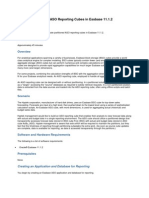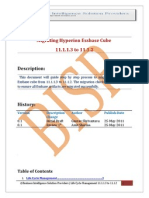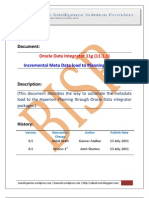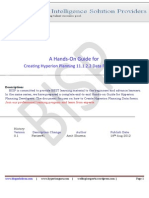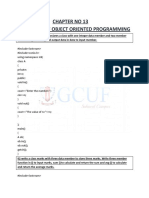Prior and MDshift Functions
Uploaded by
Vish YrdyPrior and MDshift Functions
Uploaded by
Vish Yrdy@PRIOR
The PRIOR function provides a way to compare a member outside of the Time_Period dimension in
multiple Time_Period members. For example, accounts for July could be compared to June, or Quarter
2 could be compared to Quarter 1. There are two parameters that this function accepts. The first is the
member to get the prior value for. The second is the number of periods you want to shift the
comparison. If @PRIOR(Asset123,1) is used, it would provide the value for the period previous to
what you had selected in the Time_Period member. So, if June was selected, it would provide the value
for May. If the formula was @PRIOR(Asset123,2) and June was selected, the result would be the value
for April (2 periods back). The function uses members at the same generation, so
@PRIOR(Asset123,1) would provide the difference between Qtr2 and Qtr1 if Qtr2 was selected.
So, what happens if January or Qtr1 is selected? There is no previous member for these. This is where
the second function comes in to play.
@MDSHIFT
MDSHIFT is similar to PRIOR, but it lets the calculation reference members across dimensions. Where
PRIOR only allows references on one dimension, MDSHIFT allows references to move across multiple
dimensions. If the user expects to see the different between Jan and Dec of the prior year or Qtr1 to
Qtr4 of the prior year, MDSHIFT enables that to happen without hard coding the script. Again, the goal
is to have a script that doesnt need to be maintained.
MDSHIFT accepts a set of parameters. If your shift needs to occur along one dimension, it requires one
set of parameters. If your shift needs to occur along more than one dimension, it will accept multiple
sets. The functions first parameter is the member you are evaluating, just like the PRIOR function. The
next set of parameters is what can exist multiple times if you are shifting along multiple dimensions.
The set consists of three parameters, of which the first two are required. The first of the set is the
number of positions to shift. The second is the dimension to shift on. The third is a range of member to
use to shift along. If this is left blank, Essbase uses level 0 members.
To get the prior value for Jan, or Dec of the previous year, it would be MDSHIFT("Asset123",-
1,"Year",,11,"Time_Period",). The first parameter is the member to evaluate. The next two parameters
are used to reference the previous member (-1) in the Year dimension. Since the Year dimension
members are level 0, the fourth parameter is not required. The next series, or set, references Dec (+11,
or move forward 11 from Jan) of the Time_Period dimension. The last parameter is not required since
we only want to reference level 0 members again.
Putting it all together
If we put these two functions together with a basic if/then/else statement, we get a dynamic formula
that wont need to be updated as we progress through time. It would look something like this:
If(@ISMBR("Jan"))
/* if Jan, then we have to compare Jan in the current year to Dec [shift +11] in the prior year
[shift -1] */
"Asset123" - @MDSHIFT("Asset123",-1,"Year",,11,"Time_Period",);
ELSEIF(@ISMBR("Qtr1"))
/* if Qtr1, then we have to compare Qtr1 in the current year to Qtr4 [shift +3] in the prior year
[shift -1]
The last parameter includes a range since we are not using level 0, which is the default */
" Asset123" - @MDSHIFT("Asset123",-1,"Year",,3,"Time_Period",("Qtr1","Qtr2","Qtr3","Qtr4"));
ELSEIF(@ISMBR("YearTotal"))
/* if Year, then we have to compare to last year [shift -1] */
" Asset123" - @MDSHIFT("Asset123",-1,"Year",);
ELSE
/* all other members, which would include Feb through Dec */
" Asset123" - @PRIOR("Asset123",1);
ENDIF;
You might also like
- Apache Cassandra Administrator Associate - Exam Practice TestsFrom EverandApache Cassandra Administrator Associate - Exam Practice TestsNo ratings yet
- KScope14 ASOPlanning Lackpour German Pressman PDFNo ratings yetKScope14 ASOPlanning Lackpour German Pressman PDF71 pages
- Hyperion Public Sector Planning Decision PackageNo ratings yetHyperion Public Sector Planning Decision Package9 pages
- Mitsubishi FR-Z024 UL Instruction Manual PDFNo ratings yetMitsubishi FR-Z024 UL Instruction Manual PDF145 pages
- Creating Partitioned ASO Reporting Cubes in Essbase 11No ratings yetCreating Partitioned ASO Reporting Cubes in Essbase 1147 pages
- Essbase Cube Migration 11.1.1.3 To 11.1.2No ratings yetEssbase Cube Migration 11.1.1.3 To 11.1.220 pages
- Test Oracle Enterprise Performance Reporting 2016 Cloud Service Specialist AssessmentNo ratings yetTest Oracle Enterprise Performance Reporting 2016 Cloud Service Specialist Assessment17 pages
- Creating A Functional Process Control Configuration in HFM0% (1)Creating A Functional Process Control Configuration in HFM3 pages
- Chapter 5 - Preparation of Master Budget 2No ratings yetChapter 5 - Preparation of Master Budget 22 pages
- HFM Application Backup Utility DocumentNo ratings yetHFM Application Backup Utility Document13 pages
- Hyperion Enterprises Application Migration To HFM ApplicationNo ratings yetHyperion Enterprises Application Migration To HFM Application8 pages
- The Wonderful World of Oracle HFM Alternate Hierarchies: Eduardo AbariciaNo ratings yetThe Wonderful World of Oracle HFM Alternate Hierarchies: Eduardo Abaricia5 pages
- Step-By-step Process of FDMEE Default Password ChangeNo ratings yetStep-By-step Process of FDMEE Default Password Change6 pages
- Planning - Ebook - Complete Guide To Hyperion Planning in The Cloud-4No ratings yetPlanning - Ebook - Complete Guide To Hyperion Planning in The Cloud-421 pages
- A Practical Guide For "Essbase Backup and Recovery Part II": DescriptionNo ratings yetA Practical Guide For "Essbase Backup and Recovery Part II": Description11 pages
- Hyperion Planning Incremental Metadata Load Using ODI100% (7)Hyperion Planning Incremental Metadata Load Using ODI30 pages
- KSCOPE14-Face Off Hyperion Calc Manager Vs Essbase Calc ScriptsNo ratings yetKSCOPE14-Face Off Hyperion Calc Manager Vs Essbase Calc Scripts75 pages
- A Hands-On Guide For: Creating Hyperion Planning 11.1.2.2 Data Forms Part I100% (1)A Hands-On Guide For: Creating Hyperion Planning 11.1.2.2 Data Forms Part I12 pages
- Improving The Performance of Business Rules and Calculation Scripts (ID 855821.1)No ratings yetImproving The Performance of Business Rules and Calculation Scripts (ID 855821.1)1 page
- The Business Analyst's Guide to Oracle Hyperion Interactive Reporting 11From EverandThe Business Analyst's Guide to Oracle Hyperion Interactive Reporting 115/5 (1)
- Earnings Calendar US Markets FinscreenerNo ratings yetEarnings Calendar US Markets Finscreener9 pages
- Epma 101 Loading Dim Members Via Flat FileNo ratings yetEpma 101 Loading Dim Members Via Flat File14 pages
- SE411 - Matt Heinzelman Software Quality Assurance PresentationNo ratings yetSE411 - Matt Heinzelman Software Quality Assurance Presentation39 pages
- Multi Company and Extended Multi CompanyNo ratings yetMulti Company and Extended Multi Company47 pages
- Press Brake Estun E200P Installation ManualNo ratings yetPress Brake Estun E200P Installation Manual41 pages
- Object Oriented Programming and Java (MC221) July 2007No ratings yetObject Oriented Programming and Java (MC221) July 200716 pages
- A53 Z0 9 0020 M en - Technical Documentation100% (2)A53 Z0 9 0020 M en - Technical Documentation248 pages
- Object Oriental Programming First Three Chapter ProgramNo ratings yetObject Oriental Programming First Three Chapter Program56 pages
- Intro To OpenAI GPT API - Intro To OpenAI GPT API Cheatsheet - CodecademyNo ratings yetIntro To OpenAI GPT API - Intro To OpenAI GPT API Cheatsheet - Codecademy7 pages
- Quectel_EC200U&EG91xU_Series_STK_Application_Note_V1.0No ratings yetQuectel_EC200U&EG91xU_Series_STK_Application_Note_V1.035 pages













